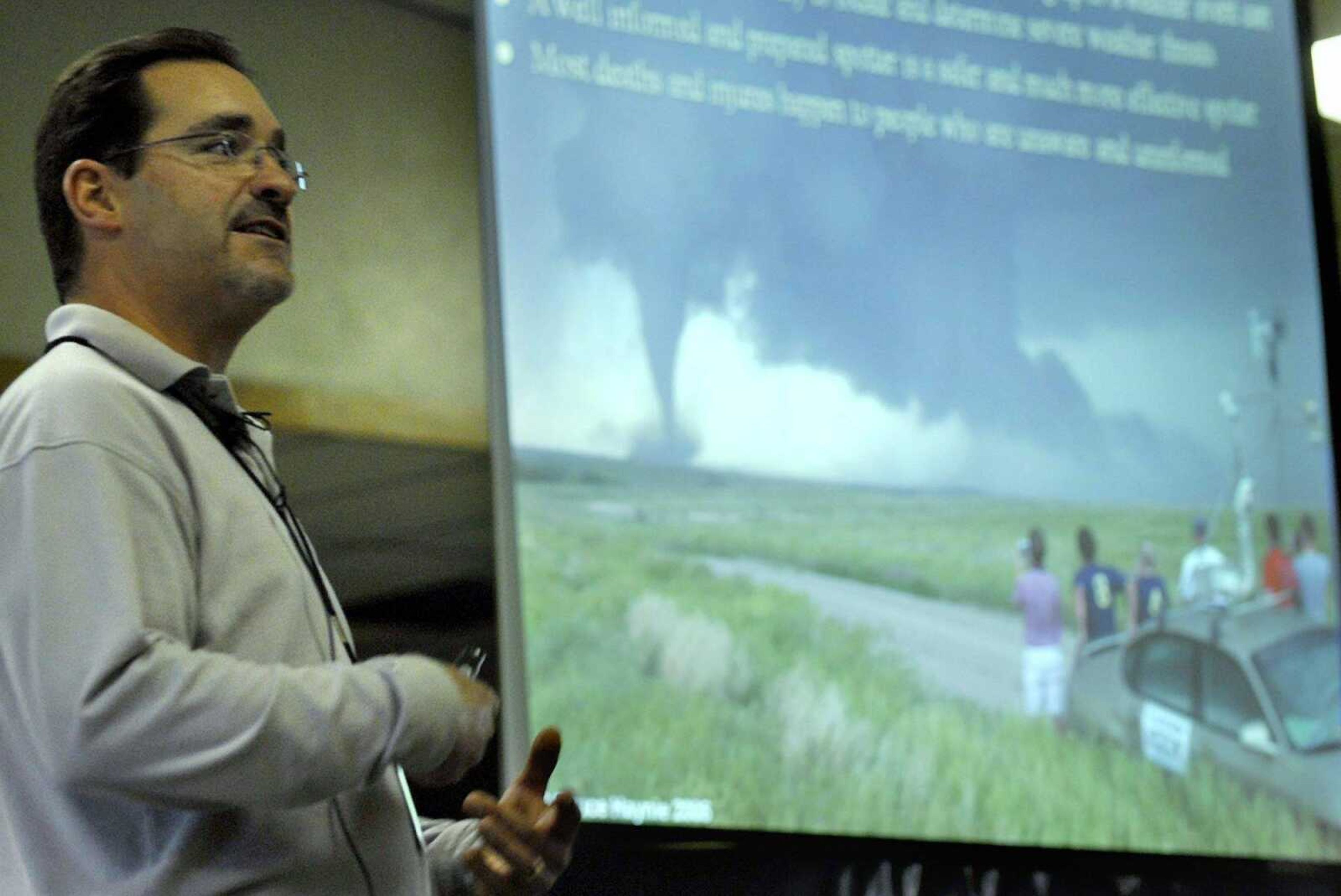National Weather Service trains spotters in Jackson
Until Tuesday night, Linda Doerge of Patton, Mo., was sure she'd experienced a tornado while living in Cape Girardeau during the 1980s. After attending a National Weather Service class on spotting hazardous weather, she knows how to tell the difference between tornadoes and the straight-line winds she experienced...
Until Tuesday night, Linda Doerge of Patton, Mo., was sure she'd experienced a tornado while living in Cape Girardeau during the 1980s.
After attending a National Weather Service class on spotting hazardous weather, she knows how to tell the difference between tornadoes and the straight-line winds she experienced.
Doerge said she'll use Tuesday's lessons in her role as emergency planner for the Cape Girardeau County Public Health Center.
Cape Girardeau County Emergency Management director Richard Knaup organized Tuesday's class, which drew nearly 70 people to the Knights of Columbus hall in Jackson, including firefighters, school officials, church members, amateur radio operators, county workers and Jackson Alderman Dave Reiminger.
Greg Meffert, one of five lead forecasters for the weather service's Paducah, Ky., office led the class. He said trained volunteer spotters lend credibility to weather reports based on radar readings. Radar doesn't reflect weather patterns below 10,000 feet, he said, and takes up to six minutes to make a full cycle.
"We need people out there to fill those gaps," he said.
He gave an illustrated lesson in reading storm clouds and tips for staying safe while reporting on hazardous weather.
Sean Mitchell, a volunteer Millersville firefighter, attended the class to refresh his spotting skills. He said he learned "you can never be too careful."
Mark Lunsford of Jackson plans to volunteer at the Millersville department. He brought his daughter, Whitney, 17, along. He was impressed at having a guide to determine wind speeds using the 12-point Beaufort Scale, which uses movement of leaves and various kinds of damage as a visual guide. Whitney Lunsford said she is fascinated by tornadoes and liked learning the difference between those and straight-line winds.
She jotted notes as Meffert explained that a funnel cloud rotates in the air, but "by definition, a tornado has to touch the ground. It has to be rotating."
He showed a series of images and short videos of tornadoes at various stages of development.
Meffert also stressed safety and the importance of having a weather alert radio. He told the crowd that 25 people living in an Evansville, Ind., mobile home park died in 2005 when a tornado struck around midnight. The weather service had issued a warning 20 minutes before the funnel cloud hit the ground, but none of those who died had NOAA weather radios, which would have alerted them to the danger, he said. The weather radios can also be used for other emergencies, from earthquakes to terrorist attacks, he said.
As for safety, he said, "it's amazing how many people's last words are 'Hey, watch this!' We don't want anybody getting hurt. We can't emphasize this enough."
On average, the Paducah office's warning area experiences 335 hazardous weather events each year, including extreme wind, dangerous hail and tornadoes. He said an average of 20 tornadoes occur each year.
Meffert told the crowd he had his own close call last year while driving to Jackson to teach a spotter class. As he traveled the interstate near Sikeston, Mo., he saw high winds blow semi-trailers off the road.
He said about half of all the people killed in floods are in their vehicles.
"Don't drive around barricades. They're there for a reason," he said.
Lightning strikes are another underestimated weather hazard, at times striking as far as five miles away from a storm. He said a man was killed near Carbondale, Ill., last year by just such a distant strike.
"As soon as you hear thunder, that's the time to get in. You don't go back out until 30 minutes after the last rumble of thunder," he said. More than half the lightning deaths in the United States occur after a storm has passed.
He said the best vantage point for spotting is on the south side of a storm but driving through the storm to get there -- which is called core punching -- "is a big no-no."
He said the weather service would rather have people watch the skies and rivers from a safe place.
After a brief break, Knaup asked the spotters to remember that after they call or use the Internet to report a weather hazard, he wants them to make a second call to the Cape Girardeau County's emergency operations center with the same report.
"Why? Because I have to fill out the paperwork for FEMA," he said. He said the emergency operations center is activated during warnings, not watches, and that if anyone hears a weather siren in Cape Girardeau County, that indicates a tornado warning.
Spotters don't get paid for their work, but they get "a sense of worth and helping the community -- helping to protect lives and property, along with the National Weather Service," Meffert said.
The National Weather Service spotter class schedule is online at www.crh.noaa.gov/pah/?n=spottertraining.
pmcnichol@semissourian.com
388-3646
Tornadoes by the numbers in the National Weather Service Paducah, Ky., watch area:
58: Counties in the Paducah office's four-state region.
20: The average number of tornadoes per year.
38: People killed by tornadoes since 1996.
34: Deaths from nighttime tornadoes since 1996.
32: People killed in mobile homes.
4: People killed in vehicles.
Connect with the Southeast Missourian Newsroom:
For corrections to this story or other insights for the editor, click here. To submit a letter to the editor, click here. To learn about the Southeast Missourian’s AI Policy, click here.










